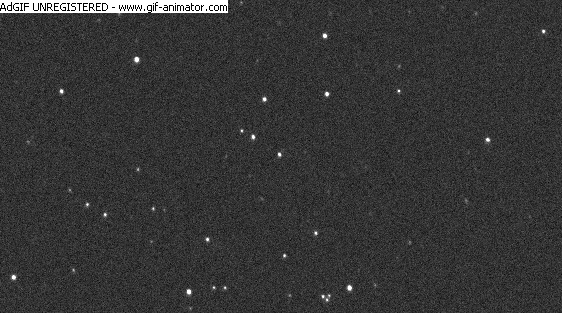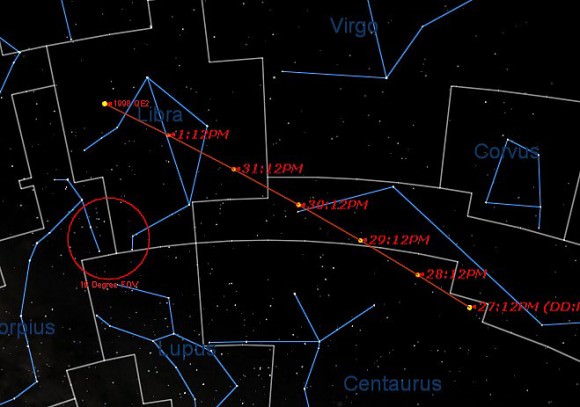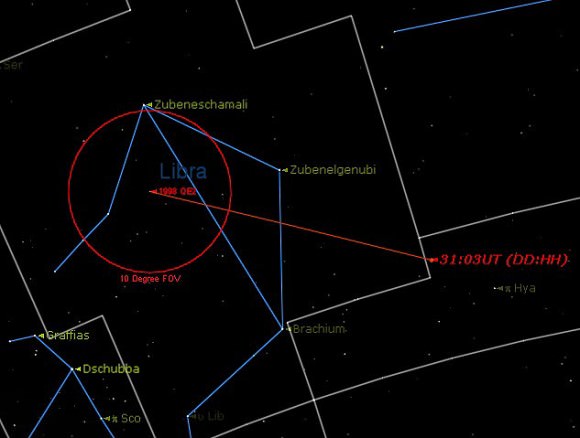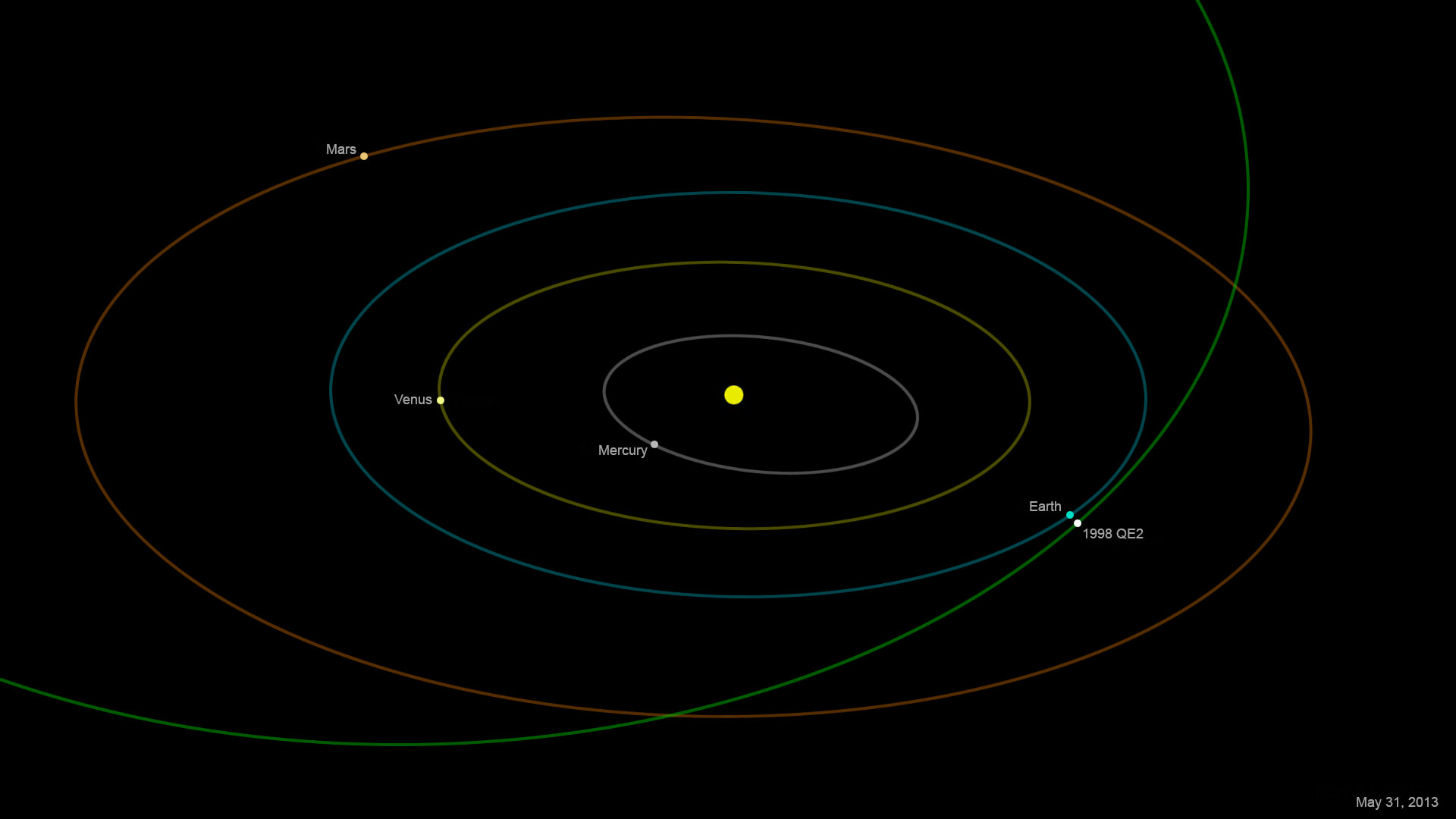A large asteroid visits our fair corner of the solar system this week, and with a little planning you may just be able to spot it.
Near Earth Asteroid (NEA) 285263 (1998 QE2) will pass 5.8 million kilometres from the Earth on Friday, May 31st at 20:59 Universal Time (UT) or 4:59PM EDT. Discovered in 1998 during the LIncoln Near-Earth Asteroid Research (LINEAR) sky survey looking for such objects, 1998 QE2 will shine at magnitude +10 to +12 on closest approach. Estimates of its size vary from 1.3 to 2.9 kilometres, with observations by the Spitzer Space Telescope in 2010 placing the ballpark figure towards the high end of the scale at 2.7 kilometres in diameter.
1998 QE2 would fit nicely with room to spare in Oregon’s 8 kilometre-wide Crater Lake.
Though this passage is over 15 times as distant as the Earth’s Moon, the relative size of this space rock makes it of interest. This is the closest approach of 1998 QE2 for this century, and there are plans to study it with both the Arecibo and Goldstone radio telescopes to get a better description of its size and rotation as it sails by. Expect to see radar maps of 1998 QE2 by this weekend.
“Asteroid 1998 QE2 will be an outstanding radar imaging target… we expect to obtain a series of high-resolution images that could reveal a wealth of surface features,” said astronomer and principal JPL investigator Lance Benner.

(Credit: Nick Howes & Ernesto Guido).
An Amor-class asteroid, 1998 QE2 has an orbit of 3.77 years that takes it from the asteroid belt between Mars and Jupiter to just exterior of the Earth’s orbit. 1998 QE2 currently comes back around to our vicinity roughly every 15 years, completing about 4 orbits as it does so. Its perihelion exterior to our own makes it no threat to the Earth. This week’s passage is the closest for 1998 QE2 until a slightly closer pass on 0.038 Astronomical Units on May 27th, 2221. Note that on both years, the Earth is just over a month from aphelion (its farthest point from the Sun) which falls in early July.
Of course, the “QE2” designation has resulted in the inevitable comparisons to the size of the asteroid in relation to the Queen Elizabeth II cruise liner. Asteroid designations are derived from the sequence in which they were discovered in a given year. 1998 QE2 was the 55th asteroid discovered in the period running from August 1st to 16th 1998.
Perhaps we could start measuring asteroids in new and creative units, such as “Death Stars” or “Battlestars?”
But the good news is, you can search for 1998 QE2 starting tonight. The asteroid is currently at +12th magnitude in the constellation Centaurus and will be cruising through Hydra on its way north into Libra Friday on May 31st. You’ll need a telescope to track the asteroid as it will never top +10th magnitude, which is the general threshold for binocular viewing under dark skies. Its relative southern declination at closest approach means that 1998 QE2 will be best observed from northern latitudes of +35° southward. The farther south you are, the higher it will be placed in the sky after dusk.

Still, if you can spot the constellation Libra, it’s worth a try. Many observers in the southern U.S. fail to realize that southern hemisphere sites like Omega Centauri in the constellation Centaurus are visible in the evening low to the south at this time of year. Libra sits on the meridian at local midnight due south for northern hemisphere observers, making it a good time to try for the tiny asteroid.
Visually, 1998 QE2 will look like a tiny, star-like point in the eye-piece of a telescope. Use low power and sketch or photograph the field of view and compare the positions of objects about 10 minutes apart. Has anything moved? We caught sight of asteroid 4179 Toutatis last year using this method.

1998 QE2 will also pass near some interesting objects that will serve as good “guideposts” to track its progress.
We find the asteroid about 5° north of the bright +2.5 magnitude star Iota Centauri on the night of May 28th. It then crosses the border into the constellation Hydra about 6° south of the +3 magnitude star Gamma Hydrae (Star Trek fans will recall that this star lies in the Neutral Zone) on May 29th. Keep a careful eye on 1998 QE2 as it passes within 30’ (about the diameter of a Full Moon) of the +8th magnitude galaxy Messier 83 centered on May 28th at 19:00 UT/3:00 PM EDT. This will provide a fine opportunity to construct a stop-motion animated .gif of the asteroid passing by the galaxy.
Another good opportunity to pinpoint the asteroid comes on the night on Thursday, May 30th as it passes within 30’ of the +3.3 magnitude star Pi Hydrae.
From there, it’s on to closest approach day. 1998 QE2 crosses into the constellation Libra early on Friday May 31st. The Moon will be at Last Quarter phase and won’t rise until well past local midnight, aiding in your quest.
At its closest approach, 1998 QE2 have an apparent motion of about 1 angular degree every 3 hours, or about 2/3rds the diameter of a Full Moon every hour. This isn’t quite fast enough to see in real time like asteroid 2012 DA14 was earlier this year, but you should notice its motion after about 10 minutes at medium power. Passing at ~465 Earth diameters distant, 1998 QE2 will show a maximum parallax displacement of just a little over 7 arc minutes at closest approach.
For telescopes equipped with setting circles, knowing the asteroid’s precise position is crucial. This allows you to aim at a fixed position just ahead of its path and “ambush” it as it drifts by. For the most precise positions in right ascension and declination, be sure to check out JPL’s ephemeris generator for 1998 QE2.
After its closest passage, 1998 QE2 will pass between the +3.3 & +2.7 magnitude stars Brachium (Sigma Librae) and Zubenelgenubi (Alpha Librae) around 4:00 UT on June 1st. Dedicated observers can continue to follow its northeastward trek into early June.
Slooh will also be carrying the passage of 1998 QE2 on Friday, May 31st starting at 5:00 PM EDT/21:00 UT.
Of course, the hypothetical impact of a space rock the size of 1998 QE2 would spell a very bad day for the Earth. The Chicxulub impact basin off of the Yucatán Peninsula was formed by a 10 kilometre impactor about 4 times larger than 1998 QE2 about 65 million years ago. We can be thankful that 1998 QE2 isn’t headed our way as we watch it drift silently by this week. Hey, unlike the dinosaurs, WE have a space program… perhaps, to paraphrase science fiction author Larry Niven, we can hear the asteroid whisper as we track its progress across the night sky, asking humanity “How’s that space program coming along?”

